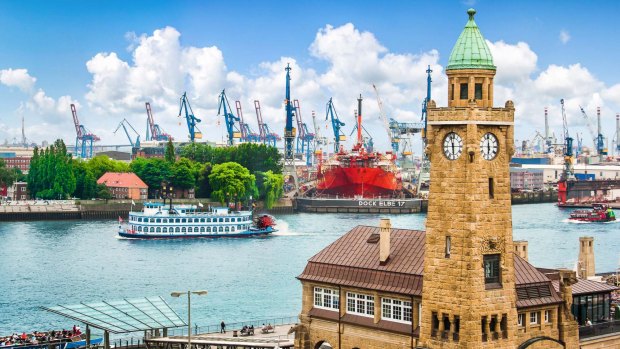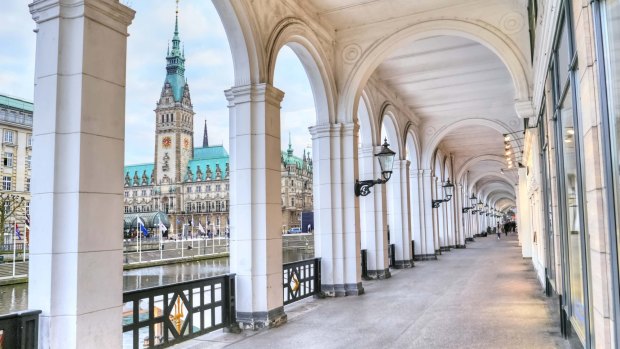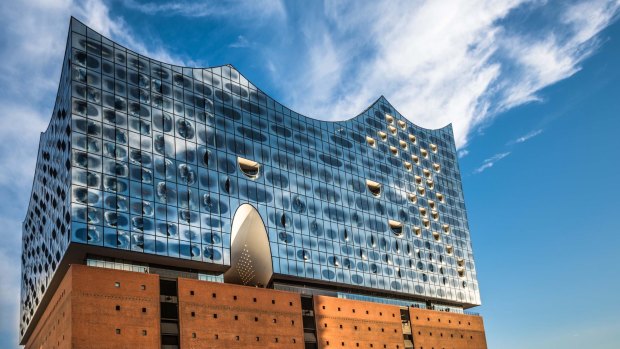This was published 5 years ago
Hamburg, Germany, things to do: A postwar city of shipping, seafood and mighty new architecture
By Luke Slattery

A traditional paddle steamer sails the Elbe in Hamburg.Credit: Shutterstock
Venice and Istanbul, maritime superpowers in their day, are best approached by sea. The same is true of Hamburg, at one time continental Europe's most important trading port, and still its third biggest. But in lieu of a berth on a cruise, cargo or container ship – or a set of oars and a dinghy – I opt for a flight along Germany's seaboard. Below me is a slice of Europe rarely seen by travellers: a low-lying littoral of busy seaports and placid estuaries, and between land and open sea, the tattered hem of the Frisian Islands.
Along this stretch of delta-strewn coast, the Ems, the Weser and the Elbe pour into the North Sea. It's a geographical reminder that Germany, though an empire for only four decades, was and is a commercial sea power. And in Hamburg, a love of commerce and a feel for the sea fuse into a kind of maritime yearning – a nautical nostalgia.
I sense it on the North Sea air: crisp and insistent, even in high summer. Hamburg is a water city weaving around lakes, docks, rivers, and canals that give off a diamantine shimmer beneath a clear sky. And it's a city open, like all good ports, to the world. I note streets and alleys named after Korea, Hong Kong, Kobe, Shanghai and Osaka; a square at the new Hafen – or Harbour – City dedicated to the Portuguese explorer Ferdinand Magellan; a new tower on the Elbe named for Marco Polo.

Stunning: Hamburg's old town.Credit: Shutterstock
To get my bearings, I stroll from my central city hotel along the shore of the Inner Alster lake, before cutting into the old town with its ornate renaissance revival town hall, or Rathouse, circled by the spires of the city's ecclesiastical glories: the churches of saints Peter, Michael, Catherine and James. The church of St Nicholas, patron saint of all seafarers, was so heavily damaged in the war that only its tower remains; but what a spire it is – a 148-metre-high flamboyant neo-Gothic confection.
The old town, when viewed from this route, is not so very old. It's a typical post-war hodgepodge of modern buildings that owe their existence to the WWII devastation that came between 1939 and 1944 when about 60 per cent of the city was destroyed in some 200 allied bombing missions, and the few buildings that either survived the war with little damage or were deemed important enough to rebuild.
And yet an echo of the old medieval burg is retained in the city's modest height. With the exception of the hypodermic needle-like Heinrich Hertz building, it's the church towers of aged acid green copper that command the skyline. The next tallest structure is the dreamy new Herzog & de Meuron-designed Elbphilharmonie concert hall with its whimsical wave-like roof.

The Elbphilharmonie is the emblem of the new HafenCity urban mega-development.Credit: Shutterstock
You can tell a lot about a city by its diet, and in Hamburg seafood is king. For lunch I take a table at Mutterland Colln's, Germany's oldest oyster bar, which shucked its first bivalve in 1760. The elaborately tiled interior is a little bit Lisbon and a little bit Delft, and very cosy. My starter is a selection of oysters, plump and ocean fresh, teamed with a generous glass of local riesling. For main course I opt for a labskaus, or sailor's hash, a dish typical of Hamburg with variations in all the ports of the North Sea. Its base is a purplish stew of corned beef, onion, potatoes and beetroot topped with two poached eggs. Rollmops and pickled gherkins are arranged on the side, and alongside is a basket of excellent German bread. If I were a child of five I would reassemble these ingredients into a smiley face, but as I'm a man of 50 I merely entertain the idea.
With the plate clean I order extra rollmops and the waitress is impressed. This calls for another class of riesling poured freely to goblet height. It's the kind of dish, washed down perhaps with a tankard of pilsener rather than a glass of golden wine, that a seaman might order from a smoky tavern on coming ashore.
In the early evening I settle into an outside table at a buzzy corner pub in St Georg. Reputed to be the city's gay district, to a Sydneysider it just looks like life. In among the burgers and nachos plates on the menu I find yet another labskaus, my new favourite dish. When it arrives, not so much plated as plonked down, I'm reminded that finesse plays a role with even the humblest fare. I fall asleep with a midnight sky still full of cold northern light and the rumble of revelry from the street mingling with birdsong from the tree beside my window.
I wake early, keen to get to grips with the working harbour. From my room I call reception asking for directions to the fish markets; at the concierge I confirm, metro map in hand, that I have the right directions. I step out into the dawn with a daypack, salivating at the thought of a breakfast fish burger. An hour and a change on the metro line later I arrive at Hamburg's famed red brick fish market. It's 6am and nothing is happening. A man setting up a flower stall over the road explains, with an apologetic look, that the market is "only open on Sunday"; a phrase that seems to have gone missing from the hotel staff's English vocabulary.
No matter. Looking on the bright side – and it is a brilliant morning – I and a few folk who have been sleeping rough enjoy a fine view of the working harbour along this northern stretch of the Elbe. Directly across the river rise floating docks 10 and 11 of the famed shipwrights Blohm+Voss (builders of the battleship Bismarck in the bad old days). A forest of cranes rises above a thicket of Lego-coloured containers.
It's at this point that the day really begins, with a stroll back towards the town centre past the Landungsbrucken. Built in 1839 as landing points for steamers, these festive floating docks with their tolling clocktower and copper domes now tether passenger, tour and party boats.
Further along, to the right of the Zollcanal that cuts in from this bend of the Elbe towards the old town, sprawls a remarkable ensemble of early modern commercial buildings and warehouses, coherent in both their design and warm brick finish.
The new HafenCity urban mega-development, with the Elbphilharmonie its emblem, is a wrap-around extension of this district further towards the Elbe. But my first stop, the stunning Kontorhaus area – named after its collection of sinuously curved and highly decorative early modern office buildings – is in the opposite direction across Zollcanal. Though separated by the canal and the eyesore, not to mention inconvenience, of an arterial road, the two areas – the one commercial, the other light industrial – are complementary.
Beneath the monumental dark brick arch of the 1920s Chilehaus, its mirror-like clinker brick surface splashed with reflected sunlight, I meet a man with a bike: two in fact. Tomas Kaiser runs bicycle tours of old Hamburg with a historical and architectural slant, and together we go for a spin around the neighbourhood. It's stunning.
The Speicherstadt warehouse district with its fantasia-like like Wasserschloss, or water castle, gets most of the foreign press; but it's the Kontorhaus district, for mine, that delivers the punch to the diaphragm. The district is composed of four stylistically related office buildings from the 1920s and '30s: the Messberghoff, Sprinkenhof, Mohlenhoff and Chilehaus. Conventional wisdom has it that German's aggression in World War II was caused in part by the misery of the '20s and '30s. It must have passed Hamburg by. This might be the most exuberant ensemble of commercial buildings outside Manhattan's midtown.
The chocolate brick Chilehaus, built for shipping magnate Henry Sloman and named after the country whose saltpetre mines made him his fortune, follows the sweep of Pumpen street to its juncture with Niedern, where all the curves are resolved in a cluster of sharp angles that recall a ship's prow: how very Hamburg.
Tomas Kaiser has either a key card, a lock pick or a lot of gumption, because the doors to the private foyers of the Messberghof and Sprinkenhof open magically for him. Entering in his wake, I climb the spiralling art deco-ish stairwells trying hard not to think of the "v" word.
Over coffee and a restorative cake at a cafe in the warehouse district, Kaiser explains that the German empire formed in 1871, and a little over a decade later the city of Hamburg entered the German Customs Union – a kind of free trade zone. The resulting economic boom, spurred on by rapid industrialisation, prompted the building of the warehouse district. And modern Hamburg was born.
"It is a wealthy city, a trading city, a free city, a bourgeois city," he says. "It looks towards the successful economies of Denmark and Sweden. It is, in some sense, Europe's most southerly northern city."
But Hamburg is not all about the vestiges of its early modern boom time. The HafenCity redevelopment has given a new pulse to the old port, which was almost entirely destroyed in the war. As we pedal around in bright sunshine at a leisurely pace Kaiser explains that about 2000 units have already been constructed, and 14,000 people work in the city.
The action is not all above ground, as I discover when we descend to the latest U-bahn station, HafenCity Universitat, whose LED lights shift back and forward along a spectrum of blue, green, red and mauve. It's meant to evoke the harbour reflected in the Elbe and its canals, but it does a fair impression of a high-tech disco. The university served by this design statement station is dedicated to architecture, urbanism and design.
I finish the day alone, at Clouds rooftop bar high above the legendary Reeperbahn. The scene at street level is pretty desultory. A country and western singer drones to a boozy outdoor crowd. A giant of a drag queen leads a group of Germans with the look of quiet Lutheran country folk bedazzled by the big city decadence.
From the 24th floor rooftop bar the Reeperbahn is out of mind and the harbour city is laid out before me. Beer in hand, vibey music in my ears, I trace my day's odyssey from the "only on Sunday" fishmarket on the Elbe opposite Blohm+Voss, to the floating docks, and the warehouse and Kontorhaus districts. I can make out the Chilehaus, a little like a squashed donut from this height. It's a building that, like Hamburg itself, honours its seafaring traditions and creates from this legacy something wonderfully new.
TRIP NOTES
Luke Slattery travelled with assistance from the German National Tourist Office.
MORE
FLY
British Airways operates daily flights from Heathrow to Hamburg passing over the German coast. See britishairways.com
STAY
The Hotel Reichshof in central Hamburg, a renovated 1910 original with art deco touches, has rooms from €240. See reichshof-hotel-hamburg.de
DO
Visit the Hamburg Fish Markets on a Sunday, from 5am from March to November; from 7am in the winter months. Take a tour with Tomas Kaiser, on foot or bike, email info@tomaskaiser.de
Sign up for the Traveller Deals newsletter
Get exclusive travel deals delivered straight to your inbox. Sign up now.